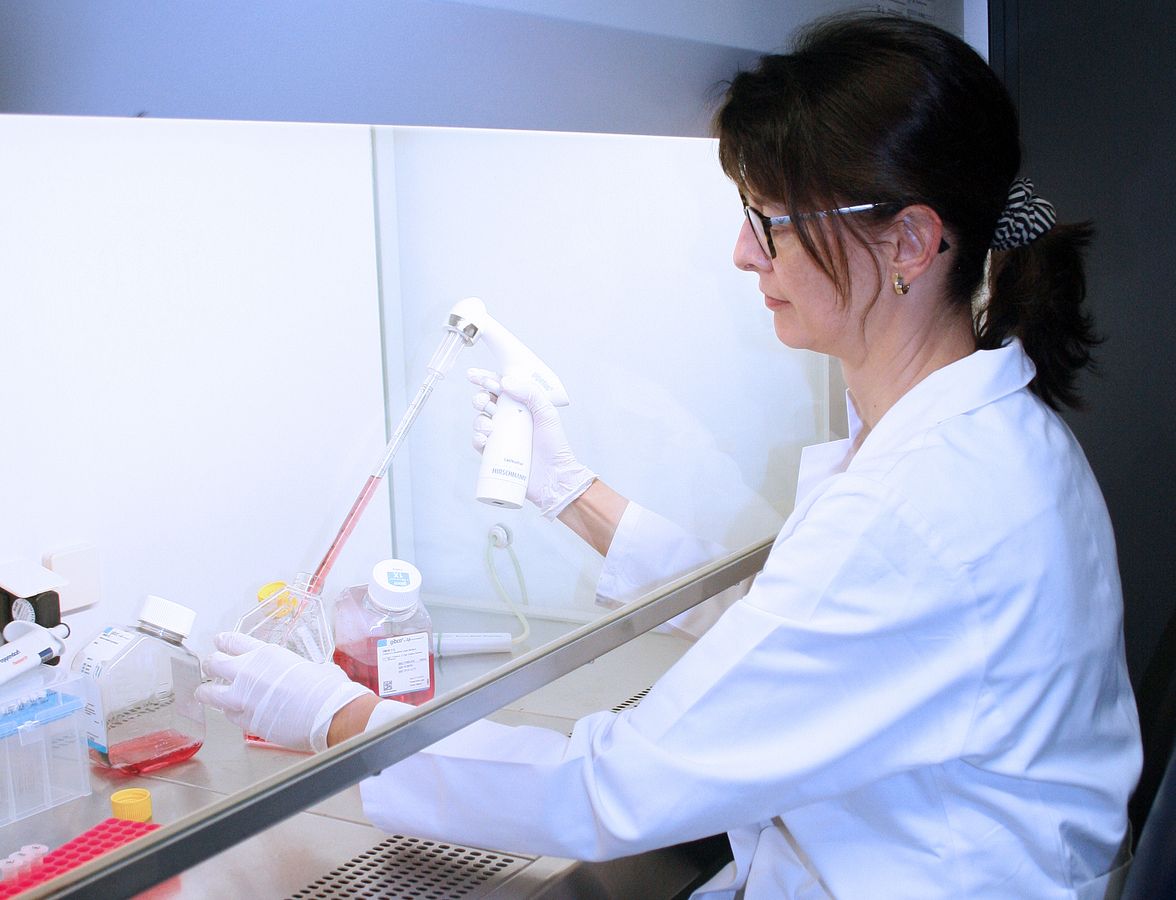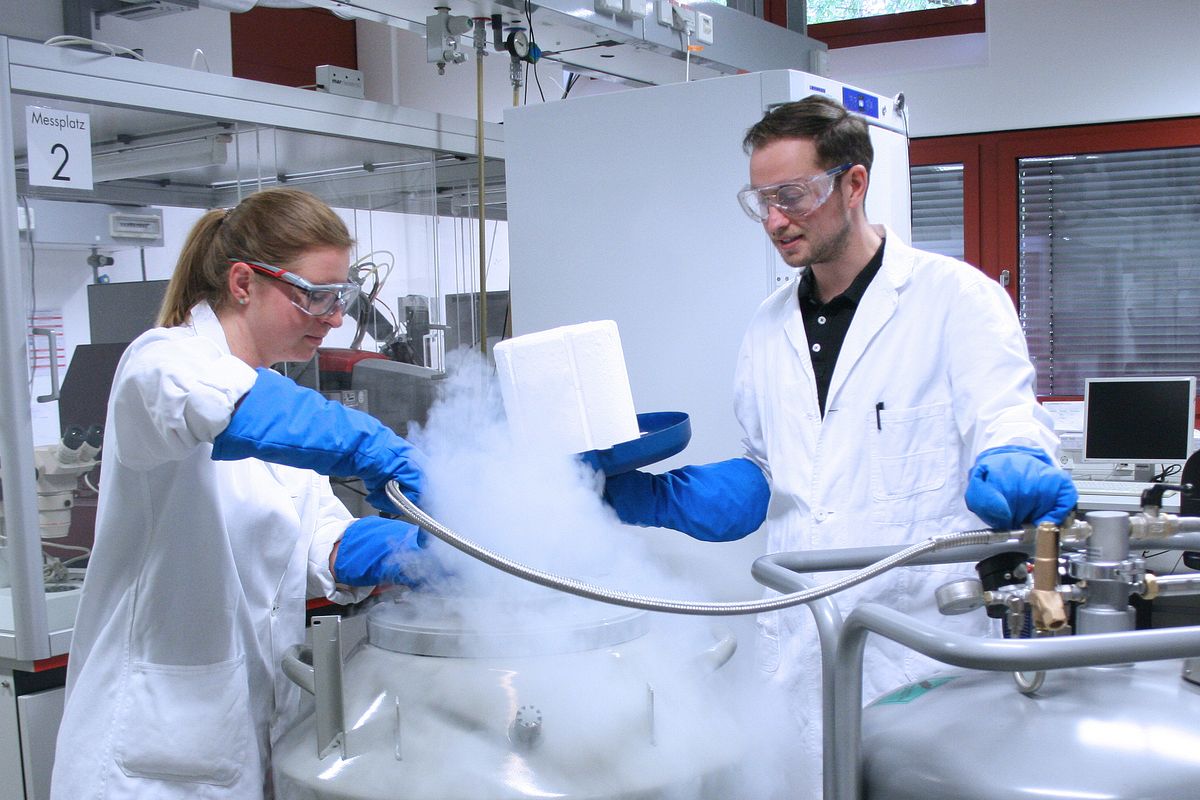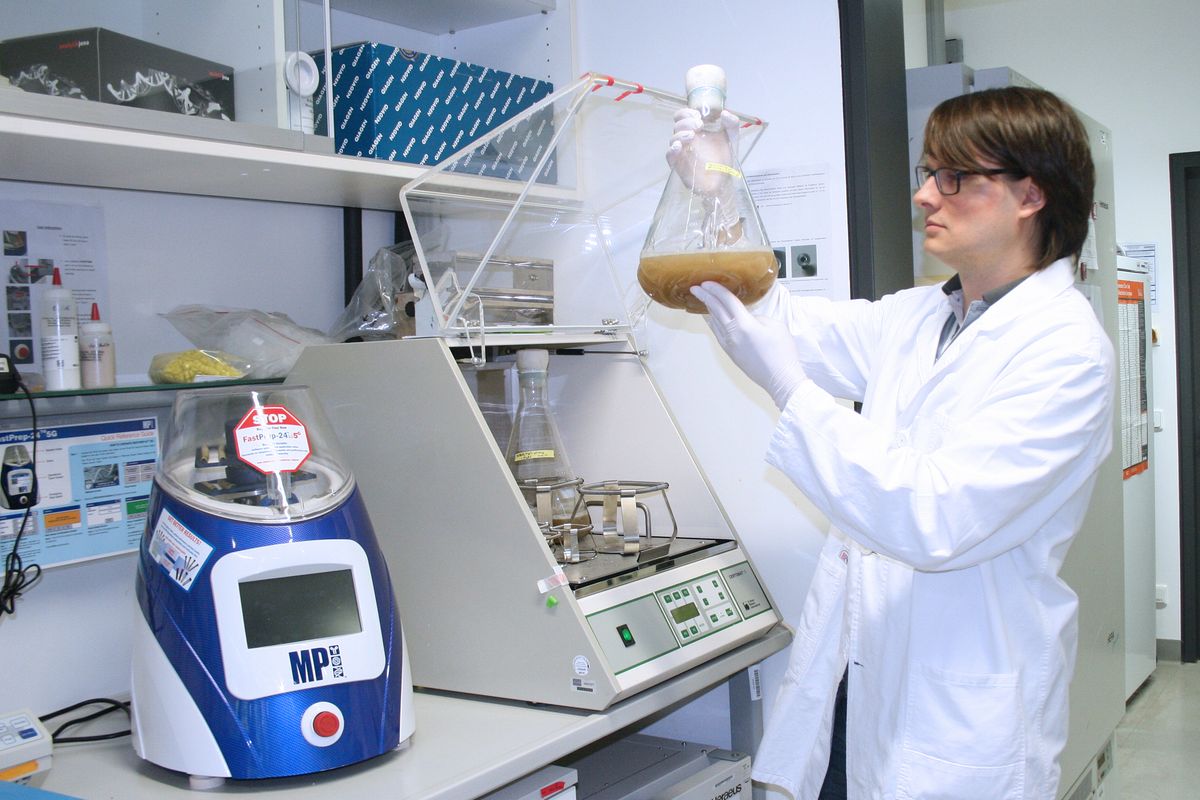Below you will find information about the courses in the Bachelor's and Master's programs in Biochemistry.
Bachelor program winter semester
This module is probably the first opportunity for undergraduate biochemistry students to meet our research group.
Content
We participate in the practical course in the module Structure Analysis (5th semester) with the exercises X-ray I, X-ray II and X-ray III. X-ray-I and X-ray II are actually lectures in which the method of X-ray structure analysis is explained in comparison to structure determination by NMR spectroscopy and cryo-electron microscopy. In the X-ray III exercise, you will then learn the method in practice in our laboratory in groups of 4 participants, in particular crystallization, data collection and model construction.
Information
All information about the practical course can be obtained from the persons responsible for the module (Prof. Dr. Tilo Pompe and co-workers). For questions about the exercises X-ray I-III please contact Dr. R. Weiße (97-31312, Email) or Prof. Dr. N. Sträter (Email).
Bachelor modules summer semester
Information
This module consists of lecture and seminar and it is read jointly by Prof. Ralf Hoffmann and Prof. Norbert Sträter. It is intended for the 6th semester in the old bachelor program and will be read for the last time in the summer semester in SS 2021.
Objectives
To provide in-depth knowledge of important bioanalytical research methods.
Content
Topic of the lecture are biochemical basics and methods in the production and analysis of proteins and DNA. In detail the following methods are covered, which are essential for biochemical work:
- Protein analysis (protein precipitation, centrifugation, ultrafiltration, dialysis, chromatographic methods, concentration determination, electrophoresis, western blot, immunological methods, mass spectrometry, UV spectroscopy, post-translational modifications)
- Nucleic acid analysis (precipitation and purification, UV spectroscopy, gel electrophoresis, sequencing),
- Molecular biology (gene cloning, microbiological methods, isolation and amplification of DNA, PCR, mutagenesis, cell cultivation)
- Recombinant protein expression (bacterial expression and cell culture, in vitro translation, protein folding)
- Peptides in biochemical research (peptide synthesis, peptide sequencing)
The 5 CP module consists of two lecture parts of 2 SWS each. The part ”Inorganic Biochemistry“ (or ”Bioinorganic Chemistry“) is read by Prof. Hey-Hawkins and the part ”Structural Biochemistry“ by Prof. Sträter. Both parts of the lecture will be held in German language from SS2021 on.
Aims
The students know the structure and function of proteins and enzymes, as well as the role of metal ions in biological systems.
Contents
- Structural biochemistry
Methods for determining protein structures, structural chemistry of proteins and DNA/RNA, visualization of protein structures, characteristic folding types and oligomer structures, methods for determining spatial structures, protein database, structure and function of selected systems in the field of enzymes, membrane proteins, motor proteins, signal transduction, fiber proteins, etc., flexibility of proteins and conformational changes, protein folding, structure-based drug development. - Bioinorganic Chemistry
Occurrence and availability of elements, Typical bioligands, Biochemical role of metals, Physical methods, Oxygen cycle, Iron: Uptake, transport and storage, iron proteins, copper proteins, cobalamins, ”Early“ transition metals: Mo, oxygen-transferring Mo enzymes, nitrogen fixation, nickel - urease/hydrogenases, zinc structural chemistry of proteins
Materials
Structural biochemistry materials will be available for download via a password protected web link. The information will be given in the first lecture or by email.
News and results
The results of the exam and current information will be communicated by posting on the password-protected website.
Bachelor thesis

The main goal of our work is to understand the structure and function of proteins at the molecular level. The topics of the bachelor's theses are methodologically predominantly molecular biological and biochemical in nature. The work is either for the preparation of protein for crystallization and structural analysis or for functional studies by mutagenesis.
Please email and we will clarify the availability of a topic and supervisor.
Organization and timing
For a bachelor topic involving molecular biology and biochemical working methods, the module ”Bioanalytical Chemistry“ should have been attended. The bachelor thesis can then be carried out after the end of the 5th semester or during and after the 6th semester. Furthermore, it is recommended to combine the practical course ”Bioanalytical Chemistry“ with the bachelor thesis, so that there is sufficient time for familiarization with the predominantly new working methods and an interesting topic can be successfully mastered in the context of the bachelor thesis.
Topics and methods
We orientate the bachelor theses quite close to the current research work and a PhD student or postdoc supervises the work intensively. Therefore, it is difficult to formulate the topics in detail far in advance.
In general, the following techniques are learned and applied methodologically in the assigned work, regardless of the project:
- Genetic engineering work to create expression vectors (construct design, cloning techniques, primer design, PCR, DNA analytics, DNA preparation, microbiological techniques).
- Mutation analysis (creation of mutants via quik-change mutagenesis).
- Gene expression and optimization of expression conditions (cell culture techniques E. coli, HEK293, insect cells, protein analysis, SDS-PAGE, Western blotting)
- Chromatographic purification of proteins (usually by affinity chromatography (His-tag, Strep-tag, or tags for antibody columns) and size exclusion chromatography)
- Biophysical methods for protein characterization (dynamic light scattering/aggregation, melting point temperature/stability, CD spectrum, UV/Vis spectrum)
- Protein crystallization
- Enzymatic assays (mostly ecto-nucleotidases, detection of phosphate via malachite green assay, ITC assay).
- Binding assays (protein-protein, protein-ligand: microthermophoresis, ITC, fluorescence polarization)
- X-ray structure analysis (in bachelor theses usually only possible in already well established projects with strong support from the supervisor)
Master modules winter semester
The 10 CP module consists of a 2 SWS lecture and a computer lab of 3 weeks. The lecture is intended for the first or third semester. The lecture takes place partly electronically and partly in presence. The lecture is held in English. The internship usually takes place directly after the end of the lecture period.
Aims
To learn the basics and methods of protein crystallography and to apply them in practice.
Contents
By means of the method of X-ray crystallography the spatial structures of organic molecules, inorganic solids as well as biological macromolecules can be determined to atomic resolution. In the lecture the basics of these methods relevant for natural scientists are taught in a practical way. The emphasis is on biocrystallography. Topics covered include: Crystallization, crystals, symmetry and space groups, X-ray sources and detectors, data collection, diffraction of X-rays and neutrons, phase problem, phasing and phase refinement, structure solution of low molecular weight compounds using Patterson function and direct methods, structure solution of biomolecules using molecular replacement, heavy atom replacement and anomalous dispersion, model building and
structure visualization, structure refinement, validation and interpretation, comparison to structure determination using NMR or CryoEM.
Materials
The teaching materials will be made available for download via a password protected web link. Information will be provided in the first lecture or by email.
News and results
The results of the written exam and current information will be communicated by posting on the password-protected website. After handing in the protocol for the practical course, the grade will be entered in AlmaWeb.
Project work
Project work must always be supervised by a member of the Institute of Biochemistry. Therefore, you can only perform a project work in our laboratory in whole or in part in joint supervision with colleagues from the Department of Biochemistry. This is usually done in ongoing collaborative projects, e.g. in the field of adhesion GPCR together with Prof. Dr. Torsten Schöneberg or on chemerin, vaspin and other adipokines together with Prof. Dr. Annette Beck-Sickinger or Dr. Dr. John Heiker. Please contact me at strater@bbz.uni-leipzig.de if you are interested in performing project work in these areas in our laboratory.
Methods
We orient the undergraduate theses quite closely to current research and a graduate student or postdoc intensively supervises the work.
In general, the following techniques are learned and applied methodologically in the assigned work, regardless of the project:
- Genetic engineering work to create expression vectors (construct design, cloning techniques, primer design, PCR, DNA analytics, DNA preparation, microbiological techniques).
- Mutation analysis (creation of mutants via quik-change mutagenesis).
- Gene expression and optimization of expression conditions (cell culture techniques E. coli, HEK293, insect cells, protein analysis, SDS-PAGE, Western blotting)
- Chromatographic purification of proteins (usually by affinity chromatography (His-tag, Strep-tag, or tags for antibody columns) and size exclusion chromatography)
- Biophysical methods for protein characterization (dynamic light scattering/aggregation, melting point temperature/stability, CD spectrum, UV/Vis spectrum)
- Protein crystallization
- Enzymatic assays (mostly ecto-nucleotidases, detection of phosphate via malachite green assay, ITC assay).
- Binding assays (protein-protein, protein-ligand: microthermophoresis, ITC, fluorescence polarization)
- X-ray structure analysis (is usually only possible in project work with already well-established projects with strong support from the supervisor and in preparation for a master's thesis)
Master thesis

The main goal of our work is to understand the structure and function of proteins at the molecular level. The topics of the master theses are methodologically mainly molecular biological and biochemical in nature.
Please send an email and we will clarify the availability of a topic and supervisor.
For a master thesis with molecular biological and biochemical working methods, methodologically appropriate elective modules should have been attended.
Topics and methods
We orientate the master theses quite close to the current research work and a PhD student or postdoc supervises the work intensively. Therefore, it is difficult to formulate topics in detail far in advance.
Information about our thematic research projects can be found here. In the following some typical methodological tasks are listed, which can be realized in a similar way for different thematic projects.
- Expression and characterization of a protein
An essential prerequisite for the investigation of proteins is first the development of an effective protocol for the preparation of the protein in sufficient quantities. A project with this goal may include the following working methods: Construct design, cloning, expression assay and optimization, preparative expression, purification (usually affinity chromatography and size exclusion chromatography), bioanalytical characterization (monodispersivity: dynamic light scattering, stability: dynamic scanning fluorimetry, activity: enzyme assay or binding assay or biological assay. Once the protein has been purified to the desired quality, planned studies follow, for example crystallization for X-ray structural analysis, enzyme assays and other functional studies. The main expression systems considered in our laboratory are bacterial expression in E. coli and expression in HEK293 cells. - Generation of variants and functional studies
Another common scenario is that a purification system has already been established in the laboratory for a protein, but now variants need to be generated and characterized. The motivation for this can be quite different:- The quality of the experimented protein is not sufficient (misfolding, aggregation, yield).
- The protein crystallizes and variants should be designed and experimented for new screens.
- Based on a spatial structure, hypotheses for the functionality have been generated and these hypotheses are now to be tested by mutations will be tested
- Comprehensive functional studies of a protein
Another typical type of topic concerns more comprehensive functional characterizations of a protein, for example enzymatic characterization of an enzyme or ligand binding studies of a receptor - Crystallographic studies
In a well-established project, crystallographic studies may also be the topic of a master's thesis. For example, the preparation and crystallization of an enzyme following an established procedure and subsequent binding studies of different substrates.
